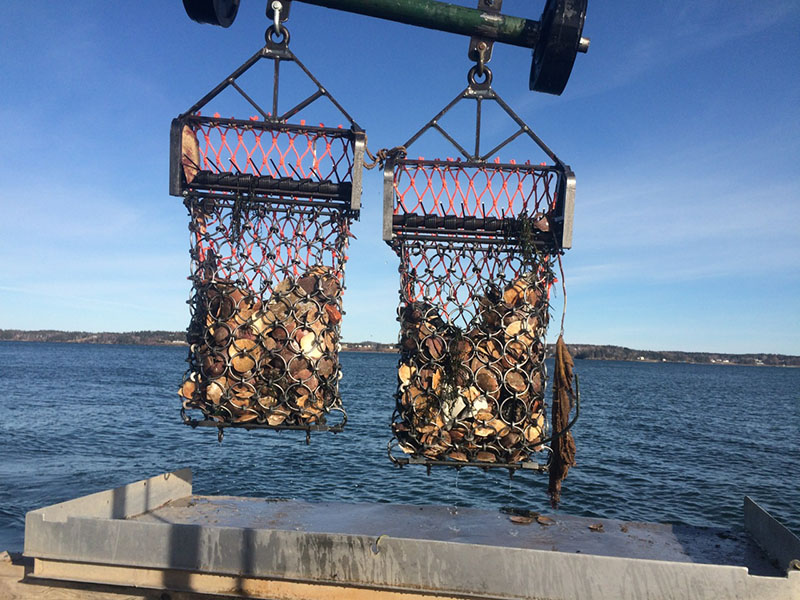Scallops are hot in Maine at the moment, and not just those searing in the kitchen.
This weekend the Maine Fishermen’s forum hosted a conference on potential changes to the northern Gulf of Maine scallop regulations, as well as a scallop aquaculture seminar. Since Maine scallops are Texas-sized, traditional aquaculture lantern or pearl nets are just too small to be practical. One possible solution is using a Japanese technique of punching a hole in the ear of the shell, and then stringing the scallop on a line for growout. When they are ready to harvest, you pull the entire string of scallops up, and voila! They are ready to shuck.
Of course, harvesting in the wild doesn’t work like that, which is why scallopers have been drawn to the N-Viro Dredge, marketed by Tim Sheehan, who also owns Gulf of Maine, a company that specializes in collecting marine life specimens.
This new dredge is an off-the-shelf option for dayboat scallopers. It’s manufactured in the United Kingdom using jigs and has replaceable parts, which is far different from the hand-built, one-of-a kind dredges most scallopers use today. Feedback from the crews using it say it catches clean and catches well. (Catch my feature on the N-Viro dredge in the NF March issue.)
However, Maine Department of Marine Resources regulations stipulate how scallop rings can be attached to one another on the top of the dredge:
“No chafing gear or cookies shall be used on top of a scallop dredge.” Chafing gear or cookies are defined as “steel, rubberized, or other types of donut rings, disks, washers, twine, or other material attached to or between the steel rings of a sea scallop drag or dredge.”
So what’s this all have to do with the N-Viro dredges? They are made overseas, in a factory, where it’s more efficient to use flat steel washers to connect the rings while assembling the mesh bags. The washers hold the rings tightly together and form a nice bag for the catch.

A detailed look at the top of an N-viro Dredge and the washers in question. Because the dredge was laying flat for the photo, the spacing between rings isn’t as apparent as when the dredge is operational, but the welding marks on the rings illustrate how the bag is assembled. After each open ring is slipped into the washer, it’s tack-welded closed. An alternative is to use solid rings and secure with links that are pressed closed with a special crimping tool. JP Vellotti photo.
It seems, however, the bag is a little too tight.
“The issue with the (N-Viro) dredge is that by using washers between the rings, it reduces the space between the rings,” said Maj. Rene Cloutier of the Maine Department of Marine Resources. “There’s noticeably less room for escapement with dredges using washers than those dredges using links.”
Links are compressed with a special tool that, when placed in a pattern on the top of the bag, creates a diamond-sized escape hatch for juvenile bycatch.
But there’s a snag here, too.
“The links are 3/8-inch and the rings (on the N-Viro) are 1/4-inch,” said Sheehan. Campbell, the company that makes the links, doesn’t offer any sizes of either the links or the crimping tool, and Sheehan has yet to find a substitute. Because of the difference in the ring diameter, a full 6-inch diamond is created, which allows valuable legal-sized scallops to escape the dredge.
But there’s even more of an issue at hand, and that has to do with legal territories. If you go a little farther north to Canadian waters, not only are the washers legal, you can drop to a 3-inch ring. You would think, then, that N-Viros would be flying off the shelf headed there. But the Canadian authorities, while saying they dredge was not “illegal to use,” it still had to get the blessings of a higher department office.
So where does that leave the individual scalloper? For now, they are responsible to modify the dredges as required in the guidelines. But a meeting of the Scallop Advisory Board — with Sheehan, DMR and others — is planned.
Part of that is going to be talking about what constitutes the definition of a “washer.”
“Those guys using Digby bags are using rubber washers, as that’s the only way to keep those rings together,” said Sheehan. “And those bags are very much like the top of our bags.”
We’ll see what comes out in the washer.







